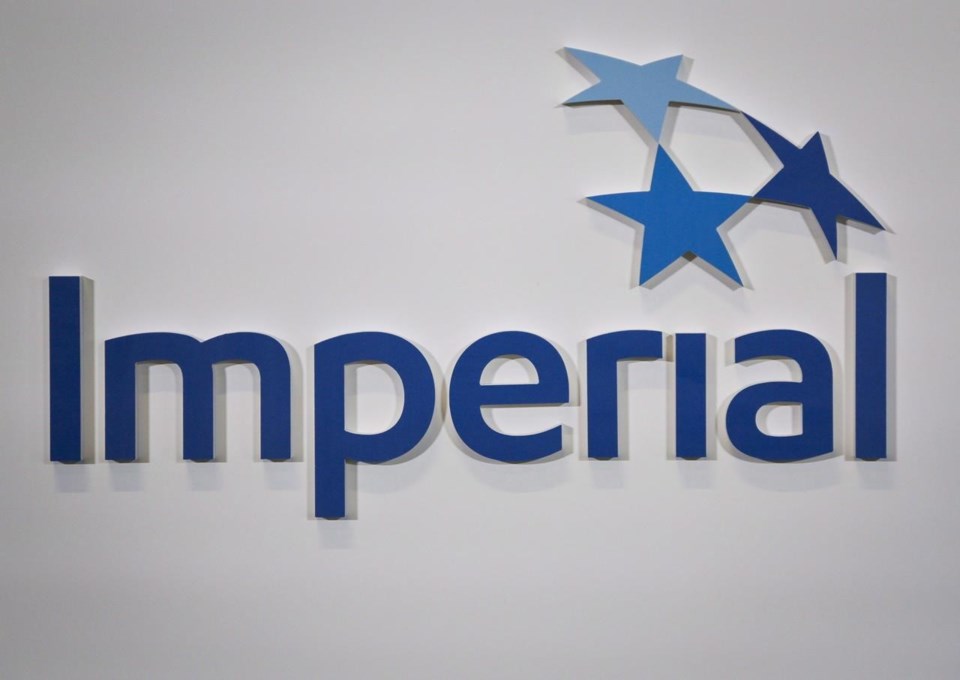CALGARY — Imperial Oil Ltd. expects "double-digit returns" from its $720-million investment to build what will be Canada's largest renewable diesel manufacturing facility at its Strathcona refinery, the oil giant said Tuesday.
The Calgary-based company announced last week its plans to go ahead with the project on the outskirts of Edmonton that was first announced in August 2021, is expected to produce 20,000 barrels per day of renewable diesel once complete in 2025.
The project, which will use locally sourced vegetable oils and low-carbon hydrogen to produce a biomass-based fuel, will help to set Imperial up for the energy transition by diversifying its petroleum-based portfolio, according to the company.
But executives told analysts on the company's fourth-quarter earnings call Tuesday that the project will also be a money-maker in its own right.
"There's nothing about the fact that it's a renewable diesel project, or driven by regulatory compliance, that in any way suggests that its rate of return is below our portfolio," said Jon Wetmore, Imperial's vice-president for downstream.
"It's very, very competitive and at the top of our portfolio."
Imperial had indicated in March 2022 that it expected its proposed renewable diesel facility to cost approximately $500 million. Costs have risen since then, in part due to inflationary pressures on labour and materials, but also because Imperial added rail logistics to the project's scope.
Imperial's chairman Brad Corson said while that did increase the project's total cost, it will also enable Imperial to reach more markets.
"I can assure you, it's a very robust return," he said.
"It's a double-digit return and it competes very well with other projects in our portfolio that are competing for capital and hence, the reason we took it to (a final investment decision)."
The comments come as Imperial celebrated a fourth-quarter profit that more than doubled compared with a year earlier, helped by a strong operating performance across all of its business.
The company said it earned $1.73 billion or $2.86 per diluted share for the quarter, up from $813 million or $1.18 per diluted share a year earlier.
Total revenue and other income for the three-month period amounted to $14.45 billion, up from $12.31 billion in the fourth quarter of 2021.
Thanks to strong commodity prices in 2022, Imperial reported full-year earnings of $7.34 billion, the highest in the company's history. It also delivered record shareholder returns, driven by a 63 per cent increase to its dividend and more than $6 billion in share buybacks.
"We are closing the books on what was the best year in the company's history, a stark contrast to the challenges we faced just two years ago at the depths of COVID," Corson said.
Imperial's upstream production in the fourth quarter averaged 441,000 gross oil-equivalent barrels per day, compared with 445,000 in the same period of 2021. Refinery throughput averaged 433,000 barrels per day for the quarter, up from 416,000 barrels per day a year earlier.
Imperial also announced Tuesday a companywide goal to achieve net-zero greenhouse emissions by 2050 across all of its operated assets, not just oilsands.
The company said it aims to achieve this through "collaboration with government and other industry partners, successful technology development and deployment and supportive fiscal and regulatory frameworks."
As part of the Pathways Alliance, a consortium of Canada's largest oilsands companies, Imperial had already ledged to reduce its greenhouse gas emissions from oilsands production to net-zero by 2050.
The Pathways group has proposed building a massive carbon capture and storage network in northern Alberta, that could see member companies invest $16.5 billion before 2030.
Corson said Pathways can't make a final investment decision on that project until the federal government commits to a level of financial support that would put 91įŁ┤┤ carbon capture projects on equal footing with those in the U.S., where they benefit from government incentives in that country's Inflation Reduction Act.
While the federal government has already announced an investment tax credit for carbon capture projects, the industry also wants to see ongoing financial support on the operating side.
However, Corson said both the federal government and the Alberta provincial government understand the issues, and are committed to seeing the proposed project go ahead.
"So I'm optimistic that if it's not in the budget speech, it will be soon thereafter that we will get not just clarity, but resolution — so we can move forward on these projects," Corson said.
Alberta’s oil and gas sector is the country’s largest polluter, and while oilsands companies have managed to reduce their emissions per barrel, total emissions from the oilsands have more than doubled since 2005 due to increased production.
This report by The 91įŁ┤┤ Press was first published Jan. 31, 2023.
Companies in this story: (TSX:IMO)
Amanda Stephenson, The 91įŁ┤┤ Press



